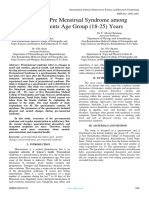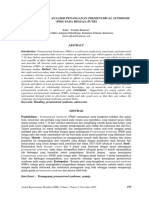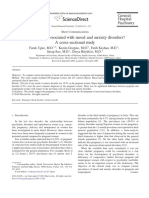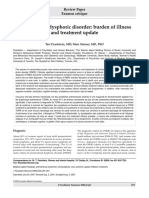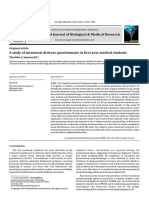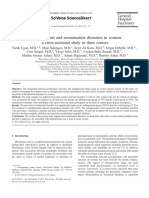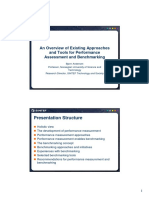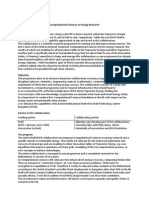Professional Documents
Culture Documents
A Study To Assess of Knowledge and Perception of Women Regarding Premenstrual Dysphoric Disorder and Its Impact On Daily Routine Work
Original Title
Copyright
Available Formats
Share this document
Did you find this document useful?
Is this content inappropriate?
Report this DocumentCopyright:
Available Formats
A Study To Assess of Knowledge and Perception of Women Regarding Premenstrual Dysphoric Disorder and Its Impact On Daily Routine Work
Copyright:
Available Formats
Volume 6, Issue 9, September – 2021 International Journal of Innovative Science and Research Technology
ISSN No:-2456-2165
A Study to Assess of Knowledge and Perception of
Women Regarding Premenstrual Dysphoric Disorder
and its Impact on Daily Routine Work
Dr. Ashok Kumar Dhanwal (Ph.D. Nursing)
Mr. Rajendra Kumar Sahu, M.Sc. (N), Nursing officer-
A, Mahamana Pandit Madan Mohan Malviya Cancer Centre BHU Campus, Varanasi Uttar Pradesh
Abstract:- of physical or emotional symptoms that most often occur
Background: Premenstrual dysphoric disorder (PMDD) about 5 to 11 days before a woman starts her monthly
is a women’s health problem similar to premenstrual menstrual cycle. In most cases, the symptoms stop when, or
syndrome (PMS) but is more serious than PMS. PMDD shortly after, her period begins (1) PMDD affects up to 5%
causes severe irritability, depression, or anxiety in a of women of childbearing age. Many women with PMDD
week or two before menstruation starts. Symptoms may also have anxiety or depression. (1). Between 20 and 40
usually go away two to three days after starting of percent of women experience moderate to severe
menses. PMS refers to a wide range of physical or premenstrual symptoms (PMS). Between 3 and 8 percent of
emotional symptoms that most often occur about 5 to 11 these experience symptoms that prevent them from
days before a woman starts her monthly menstrual cycle. functioning in normal daily life. This is premenstrual
PMDD affects up to 5% of women of childbearing age. dysphoric disorder (PMDD) (2). PMDD involves a set of
Aims and objectives: To assess knowledge and physical and psychological symptoms that affect daily living
perception of women about premenstrual syndrome and and threaten the individual’s mental wellbeing (2). Severe
premenstrual dysphoric disorder and their impact on stress and emotional upheaval are symptoms of PMDD that
daily routine work. Material and Methods: Cross- can affect working life and relationships. The exact cause of
sectional survey research design was adopted in the PMDD is unclear but changes in hormonal level throughout
study. Sample collection was done by using the the menstrual cycle may play a role (1). The hormone
Probability Random Sampling Technique. Where 60 changes can cause a serotonin deficiency which is found
women’s participated in this study. Self-structured naturally in the brain and intestines that narrows blood
knowledge questionnaires were used for data collection. vessels and can affect mood and cause physical symptoms.
Results: The results of the study show that majority of The prevalence of PMS in college students found 18.4%
women 53% (32) having moderate knowledge, 30% (18) where Moderate to severe PMS was 14.7% and PMDD was
having adequate knowledge, and 17% (10) having 3.7% (3) The symptoms commonly reported in Indian study
inadequate knowledge about PMS and PMDD. The are fatigue/lack of energy, decrease interest in work, and
mean score was 6.4 and the standard deviation was 1.98. anger/irritability (3). Banerjee N et al (2000) reported a
Regarding Perception majority of the woman 55 % (33) 6.4% premenstrual dysphoric disorder prevalence in 62
having favourable perceptions, 42% (25) having a women (4). Prevalence of premenstrual syndrome and
moderate level of perception, and 3% (2) having premenstrual dysphoric disorder in medical students
unfavourable perceptions. Conclusion: This study reported 65% where 12% of the study population reported
concluded that PMS and PMDD affect daily routine PMDD. Impact of PMS and PMDD on their academic and
work and need more medical attention for symptomatic social performance reported 12% of absenteeism in class
or complete medical management of PMS and PMDD. and 32% avoidance of joining social functions (5). In the
study 4.8%. Prevalence of premenstrual dysphoric disorder
Keywords:- Knowledge, PMS, PMDD, Premenstrual in school-going adolescent girls has been seen (6).
Problems. Association of PMDD with lifestyle factors, such as sleep,
physical activity, total tea/coffee intake, and change in
I. INTRODUCTION tea/coffee and food intake under stress has been seen in
medical students residing in a hostel (7). Anitha Durairaj et
Premenstrual dysphoric disorder (PMDD) is a al reported 14.3% moderate to severe PMS and PMDD 3.7%
women’s health problem similar to premenstrual syndrome prevalence in college girls. Impairment of college efficiency
(PMS) but is more serious than PMS. PMDD causes severe or productivity was seen in 82.66% and 100% of students
irritability, depression, or anxiety in a week or two before with moderate to severe PMS and PMDD respectively.
menstruation starts. Symptoms usually go away two to three Awareness about PMS was found 80% in students of Delhi
days after starting of menses. Women with PMDD need NCR but 43.8%) females knew about PMDD. The majority
medicine or other treatment to reduce symptoms (1). The 90% of female students think that PMS is an important issue
symptoms of PMDD are more severe than those seen with that should be discussed but 40.8% did nothing to relieve
premenstrual syndrome (PMS). PMS refers to a wide range their premenstrual symptoms (8). Cross-Sectional Study
IJISRT21SEP513 www.ijisrt.com 578
Volume 6, Issue 9, September – 2021 International Journal of Innovative Science and Research Technology
ISSN No:-2456-2165
about Knowledge, Attitudes, and Severity of Symptoms of Regarding marital status 27% (16) were married and
Premenstrual Syndrome calls for an education program 77 % (44) were unmarried. Regarding Area of living 37%
related to PMS and menstrual-related disorders to provide (22) are from Rural and 67% (38) are from urban areas.
information and support to adolescents (9). Seema R
Deshpande et al reported 57% of female students' studies Regarding Family type 47% (28) belong to nuclear
were affected due to PMS. Drinking hot/cold beverages type family, 43% (26) belong to Joint family, and 10% (6)
were the most commonly used coping technique (10). belong to Extended family.
Objectives Regarding the source of knowledge 45% (27) receives
1. To assess knowledge and perception of the woman about Information from Healthcare professionals, 35% (21) from
the premenstrual syndrome and premenstrual dysphoric the Internet or other online platform and 20% (12) from friends.
disorder and its impact on daily routine work.
2. To assess the impact of daily routine work due to The analysis was made based on objectives.
physical symptoms. Knowledge and perception of a woman regarding the
3. To assess the impact of daily routine work due to premenstrual dysphoric disorder and its impact on daily
psychological symptoms routine work was the first objective that was assessed in the
4. To find association of Sociodemographic variable with study found. Results revealed that the majority of women 53
knowledge and impact of daily routine work. % (32) had moderate knowledge, 30% (18) had adequate
knowledge and 17% (10) had inadequate knowledge
II. MATERIAL AND METHODS regarding PMDD. The mean score was 6.4 and the standard
deviation was 1.98.
Research Approach: Exploratory research approach with
the use of a Cross-sectional survey design is used in the Regarding Perception majority of the woman, 55 %
study. (33) had favourable perceptions, 42% (25) had a moderate
Sampling - In the present study sample collection was done level of perception and 3% (2) had unfavourable
by Probability Random Sampling Technique. Where 60 perceptions.
females participated in this study.
Inclusion Criteria Impact of emotional symptoms - 95 % of women’s was
1. Women’s age between 18- 45 Years of age. agreed that their daily routine work and social functioning
2. Participants who are willing to participate in the study. affected due to emotional symptoms of the premenstrual
dysphoric disorder.
Exclusion Criteria
1. Women who are unable to read Hindi or English. Impact of Physical symptoms - 90 % of women’s was
Tools - Self-structured knowledge questionnaire, consisted agreed that their daily routine work and social functioning
from 2 sections, Socio-demographic data (Includes affected due to physical symptoms of the premenstrual
Sociodemographic information of sample population) and dysphoric disorder.
Self-structured knowledge questionnaire (includes
Knowledge and perception), Content validation done by There was an association of family type with
subjects experts. knowledge score found where calculated chi-square value
16.86 value is greater than critical value 9.48 at 0.05
III. RESULTS significance level.
The Sociodemographic distribution in this study was There was an association of age group and education
followings – level found with a perception of women’s where calculated
The majority of women’s 83.5 % (50) belongs to the chi-square value 18.72 and 12.5 is greater than the critical
age group of 20 – 30 Years, 13.5 % (8) belongs to 31 – 40 value (df4) 9.48 at 0.05 level of significance.
Years age, and 3% (2) belongs to above 41 years of age.
IV. DISCUSSION
Regarding the level of education, 60% (36) were
graduates, 20% (12) were Post-Graduate, 20 % (12) having The result of the present study revealed that the majority of
education up to (10+2). women 53 % (32) had moderate knowledge, 30% (18) had
adequate knowledge and 17% (10) had inadequate
Regarding Occupation 40 % (24) were Govt. knowledge regarding PMDD. Results of a study done by
employees, 22% (25) had small own occupation and daily Surbhi Teotia et al done revealed that 80% of female
wages workers, and 18% (11) were Private employees. participants knew about PMS while only (43.8%) knew
about PMDD (8). Regarding Perception majority of the
Regarding Monthly Income 37 % (22) having income woman, 55 % (33) had favourable perceptions, 42% (25)
below 10000 Rupees, 28% (17) having income between had a moderate level of perception and 3% (2) had
11000 – 20000 Rupees, 35 % (21) having income above unfavourable perceptions. In this study 95 %, women’s was
21000 Rupees. agreed that their daily routine work and social functioning
affected due to emotional symptoms of the premenstrual
IJISRT21SEP513 www.ijisrt.com 579
Volume 6, Issue 9, September – 2021 International Journal of Innovative Science and Research Technology
ISSN No:-2456-2165
dysphoric disorder, and 90 % of women’s was agreed that Priyanka Yadav. 2015, Ind Psychiatry J., pp. 150–
their daily routine work and social functioning affected due 157.
to physical symptoms of the premenstrual dysphoric [8]. A Study on Premenstrual Syndrome among Female
disorder. The functional, school/work efficiency, and Students of a Private University of Delhi NCR. Surbhi
productivity impairment were found in a study done by Teotia, Sayantika Kumari, Neha Taneja, Karuna
Chintan Madhusudan et al (2016) (6). The most common Nidhi Kaur, Aanchal Anant Awasthi, Rajiv
somatic symptom body pain (52%) and the most common Janardhanan. 2020, Journal of Women’s Health and
affective symptom irritability (50%) was seen in a study Development, pp. 413-422.
done by Geeta et al (5). [9]. Knowledge, Attitudes and Severity of Symptoms of
Premenstrual Syndrome. Sonia Garg, Shilekh Mittal.
V. CONCLUSION 2015, Research Journal of Pharmaceutical, Biological
and Chemical, pp. 1160-11366.
The findings of this study have been discussed [10]. Assessment of prevalence and awareness regarding
concerning the objectives and hypothesis. Knowledge and premenstrual syndrome and its coping techniques
perception of the woman about the premenstrual syndrome among the paramedical students – A research study.
and premenstrual dysphoric disorder and its impact on daily Seema R Deshpande, Namrata R Vaishampayan,
routine work were 54% moderate, 30% adequate, and 17 % Sneha B Bevinamarad. 2019, International Journal of
inadequate. Impact of physical and emotional symptoms Medical Science and Public Health, pp. 893-896.
found in Daily routine work, Sleep, and social functioning. [11]. APA. Diagnostic And Statistical manual of mental
disorder. wasinghton : American Psychiatric
Conflict of interest: The authors had no associations, 2013.
relationship/condition/circumstances that present a potential [12]. Health, MGH Center for Women's Mental. MGH
conflict of interest. Center for Women's Mental Health.
womensmentalhealth.org. [Online] 01 13, 2021.
REFERENCES womensmentalhealth.org.
[13]. Prevalence, pattern and predictors of premenstrual
[1]. Womens, Health. Office of the womens Health. syndrome (PMS) and premenstrual. Durairaj A,
[Online] 2018. [Cited: January 07, 2021.] Ramamurthi R. 2019, The New Indian Journal of
https://www.womenshealth.gov/menstrual- OBGYN, p. 93.
cycle/premenstrual-syndrome/premenstrual-dysphoric- [14]. A Study to Assess the Prevalence of Premenstrual
disorder- Syndrome and Premenstrual Dysphoric Disorder and
pmdd#:~:text=Premenstrual%20dysphoric%20disorder Various Coping Strategies used by Students in A
%20(PMDD)%20is,days%20after%20your%20period Womens Medical College from South India.
%20starts.. Sivanandh Budarapu, Haripriya Sadam, Harshitha
[2]. Smith, Lori. Medical News Today. Medical News K, Divya Nageswari M, Harshitha Reddy K, Gouri
Today. [Online] July 18, 2018. Dhanekula. International Journal of Contemporary
https://www.medicalnewstoday.com/articles/308332. Medical Research, pp. 77-83.
[3]. Prevalence of premenstrual syndrome and
premenstrual dysphoric disorder among college
students of Bhavnagar, Gujarat. Chintan
Madhusudan Raval, Bharat Navinchandra
Panchal, Deepak Sachidanand Tiwari, Ashok
Ukabhai Vala, and Renish Bhupendrabhai Bhatt.
2016, Indian J Psychiatry, pp. 164–170.
[4]. Premenstrual dysphoric disorder--a study from India.
Banerjee N, Roy KK, Takkar D. 2000, , International
Journal of Fertility and Women's Medicine, pp. 342-
344.
[5]. Prevalence of premenstrual syndrome and Mr. Rajendra Kumar Sahu
premenstrual dysphoric. Geeta Shamnani, Vani Dr. Ashok Kumar M.Sc.(N), Nursing officer-
Gupta, Rekha Jiwane, Shraddha Singh, Sunita Dhanwal A, Mahamana Pandit
Tiwari, Shekhawat Singh Bhartiy. 2018, National Ph.D. Nursing Madan Mohan Malviya
Journal of Physiology, Pharmacy and Pharmacology, Cancer Centre BHU
p. . Campus, Varanasi Uttar
[6]. Prevalence of premenstrual dysphoric disorder among Pradesh
school-going adolescent girls . Madhu Gupta,
Devakshi Dua, Harsheen Kaur, and Sandeep
Grover. 2019, Ind Psychiatry J., pp. 198–202.
[7]. Premenstrual dysphoric disorder in medical students
residing in hostel and its association with lifestyle
factors. Amrita Mishra, Girish Banwari, and
IJISRT21SEP513 www.ijisrt.com 580
You might also like
- Knowledge, Attitudes, and Perceptions of Preeclampsia Among First-Generation Nigerian Women in the United StatesFrom EverandKnowledge, Attitudes, and Perceptions of Preeclampsia Among First-Generation Nigerian Women in the United StatesNo ratings yet
- Premenstrual Syndrome Among Teacher Training University Students in IranDocument4 pagesPremenstrual Syndrome Among Teacher Training University Students in IranFransiska SariNo ratings yet
- A Study of Impact of Stress Examinations On MenstrDocument6 pagesA Study of Impact of Stress Examinations On MenstrDeviona MacpalNo ratings yet
- A Study To Identify Premenstrual Syndrome and Their Management Adopted by Adolescent Girls Studying in Selected High School at Jabalpur M.PDocument4 pagesA Study To Identify Premenstrual Syndrome and Their Management Adopted by Adolescent Girls Studying in Selected High School at Jabalpur M.PEditor IJTSRDNo ratings yet
- JournalDocument5 pagesJournalNatalia ChandraNo ratings yet
- 452 Ij 12Document6 pages452 Ij 1227-Deekshitha Preeth JayaramNo ratings yet
- Roll No 23 PMS ReviewDocument2 pagesRoll No 23 PMS ReviewKainat IqbalNo ratings yet
- SomatoformDocument8 pagesSomatoformwisnuNo ratings yet
- Psychological Factors and Premenstrual Syndrome: A Spanish Case-Control StudyDocument13 pagesPsychological Factors and Premenstrual Syndrome: A Spanish Case-Control StudyFarmasi Pelita IbuNo ratings yet
- Revalence and Severity of Dysmenorrhea: A Problem Related To Menstruation, Among First and Second Year Female Medical StudentsDocument10 pagesRevalence and Severity of Dysmenorrhea: A Problem Related To Menstruation, Among First and Second Year Female Medical StudentsNuwaira BalochNo ratings yet
- Evaluation of Pre Menstrual Syndrome Among Female Students Age Group (18-25) YearsDocument4 pagesEvaluation of Pre Menstrual Syndrome Among Female Students Age Group (18-25) YearsInternational Journal of Innovative Science and Research TechnologyNo ratings yet
- Menstrual Problems Among College Students: Prevalens and Treatment Seeking BehaviorsDocument8 pagesMenstrual Problems Among College Students: Prevalens and Treatment Seeking BehaviorsAlkausyari AzizNo ratings yet
- Studi Litelatur Analisis Penanganan Premenstrual Syndrome (PMS) Pada Remaja PutriDocument8 pagesStudi Litelatur Analisis Penanganan Premenstrual Syndrome (PMS) Pada Remaja PutriReyin RahmanNo ratings yet
- Assess The Prevalence and Knowledge On Premenstrual Syndrome and Management Among Adolescents in Selected Schools in KothamangalamDocument11 pagesAssess The Prevalence and Knowledge On Premenstrual Syndrome and Management Among Adolescents in Selected Schools in KothamangalamBlessy sabuNo ratings yet
- Screening of Bipolar Disorders and Characteristics of Symptoms in Various Populations in Surabaya, IndonesiaDocument9 pagesScreening of Bipolar Disorders and Characteristics of Symptoms in Various Populations in Surabaya, IndonesiaTsu TomoNo ratings yet
- Iaim 2016 0302 17Document5 pagesIaim 2016 0302 17HemantNo ratings yet
- Article MethodologieDocument4 pagesArticle MethodologieMelany AntounNo ratings yet
- 10 1111@ppc 12656Document7 pages10 1111@ppc 12656Kalaivathanan VathananNo ratings yet
- Is Pregnancy Associated With Mood and Anxiety Disorders? A Cross-Sectional StudyDocument3 pagesIs Pregnancy Associated With Mood and Anxiety Disorders? A Cross-Sectional StudyFaizahNo ratings yet
- Hubungan Pengetahuan Dan Sikap Remaja Dalam Mengatasi DismenoreaDocument7 pagesHubungan Pengetahuan Dan Sikap Remaja Dalam Mengatasi DismenoreaSyella Elnida Depari 1911110487No ratings yet
- Prevalence of Psychiatric Disorders in Infertile Women and Men Undergoing in Vitro Fertilization TreatmentDocument8 pagesPrevalence of Psychiatric Disorders in Infertile Women and Men Undergoing in Vitro Fertilization TreatmentMaria Galia Elias QuirogaNo ratings yet
- Health Related Quality of Life Among Adolescents With Premenstrual Disorders A Cross Sectional StudyDocument5 pagesHealth Related Quality of Life Among Adolescents With Premenstrual Disorders A Cross Sectional StudynadyaNo ratings yet
- Premenstrual Dysphoric Disorder Burden of IllnessDocument11 pagesPremenstrual Dysphoric Disorder Burden of IllnessLili Bodhert MNo ratings yet
- Understanding Depression in Elderly WomenDocument49 pagesUnderstanding Depression in Elderly WomenNighat WaniNo ratings yet
- Premenstrual Syndrome and Premenstrual Dysphoric Disorder in Perimenopausal WomenDocument6 pagesPremenstrual Syndrome and Premenstrual Dysphoric Disorder in Perimenopausal WomennikuNo ratings yet
- 646-Article Text-1222-1-10-20210226Document10 pages646-Article Text-1222-1-10-20210226subanant11No ratings yet
- Prevalence and Severity of Dysmenorrhea: A Problem Related To Menstruation, Among First and Second Year Female Medical StudentsDocument9 pagesPrevalence and Severity of Dysmenorrhea: A Problem Related To Menstruation, Among First and Second Year Female Medical StudentsDeff HaningNo ratings yet
- A Study of Menstrual Distress Questionnaire in First Year Medical StudentsDocument4 pagesA Study of Menstrual Distress Questionnaire in First Year Medical StudentswidyaersafitriNo ratings yet
- Asian Journal of Psychiatry: SciencedirectDocument6 pagesAsian Journal of Psychiatry: SciencedirectdendhyNo ratings yet
- 18 Halaman 2017: 207-91-1-SM PDFDocument3 pages18 Halaman 2017: 207-91-1-SM PDFAyusukmatriputri96 AyuNo ratings yet
- Research Chap 2Document8 pagesResearch Chap 2Sreelekshmi SajuNo ratings yet
- EJHM - Volume 71 - Issue 6 - Pages 3343-3350Document8 pagesEJHM - Volume 71 - Issue 6 - Pages 3343-3350Idada EzekielNo ratings yet
- Explore The Knowledge and Impact On Dysmenorrhea Among Nursing Students of Selected CollegeDocument5 pagesExplore The Knowledge and Impact On Dysmenorrhea Among Nursing Students of Selected CollegeEditor IJTSRDNo ratings yet
- Prevalency DismenoireDocument8 pagesPrevalency DismenoireFatiya MuthmainnahNo ratings yet
- Prevalence and Predictors of Depression Amongst ElderlyDocument4 pagesPrevalence and Predictors of Depression Amongst ElderlyDr.Wajid Habib (Doxxsab)No ratings yet
- 2015 Positive and Negative Symptoms in Patients of Schizophrenia: A Cross Sectional StudyDocument5 pages2015 Positive and Negative Symptoms in Patients of Schizophrenia: A Cross Sectional StudyAtiqul Haq MazumderNo ratings yet
- 1 s2.0 S0165032721009873 MainDocument12 pages1 s2.0 S0165032721009873 MainluizaferreirainacioNo ratings yet
- The Impact of Postpartum Depression On Quality of Life in Women After Child's BirthDocument7 pagesThe Impact of Postpartum Depression On Quality of Life in Women After Child's BirthzekiNo ratings yet
- 82264-Article Text-197411-1-10-20121015 PDFDocument6 pages82264-Article Text-197411-1-10-20121015 PDFJamesNo ratings yet
- SEFT Therapy Reduces Dysmenorrhea IntensityDocument4 pagesSEFT Therapy Reduces Dysmenorrhea IntensityIntansari AdnNo ratings yet
- Cardioc DiseaseDocument8 pagesCardioc DiseaseLakshmipriya GopinathNo ratings yet
- Jurnal Back MassageDocument9 pagesJurnal Back MassageVikaniikhaNo ratings yet
- Sepede G, 2016Document21 pagesSepede G, 2016Bianca PerezNo ratings yet
- Antidepressants and Menstruation Disorders in Women: A Cross-Sectional Study in Three CentersDocument5 pagesAntidepressants and Menstruation Disorders in Women: A Cross-Sectional Study in Three CentersRavennaNo ratings yet
- Original Article: ISSN: 0976 3325Document4 pagesOriginal Article: ISSN: 0976 3325Adina OlteanuNo ratings yet
- Non-Pharmaceutical Labor Pain Relief and Postpartum DepressionDocument9 pagesNon-Pharmaceutical Labor Pain Relief and Postpartum DepressionDesi PratiwiNo ratings yet
- Knowledge, Attitudes and Experiences of MenopauseDocument5 pagesKnowledge, Attitudes and Experiences of MenopauseJojo CalimNo ratings yet
- Pcos Purposal 1Document33 pagesPcos Purposal 1sushma shrestha0% (2)
- 12-10-2021-1634022290-6-Impact - Ijranss-3. Ijranss - Systematic Review - Effect of Premenstrual Syndrome Among WomenDocument8 pages12-10-2021-1634022290-6-Impact - Ijranss-3. Ijranss - Systematic Review - Effect of Premenstrual Syndrome Among WomenImpact JournalsNo ratings yet
- IndianJObstetGynecolRes 9 2 198 203Document6 pagesIndianJObstetGynecolRes 9 2 198 203shilpi sumanNo ratings yet
- Mental Health Problems During Pregnancy and The Postpartum Period A Multicenter Knowledge Assessment Survey Among Healthcare ProvidersDocument7 pagesMental Health Problems During Pregnancy and The Postpartum Period A Multicenter Knowledge Assessment Survey Among Healthcare ProvidersRifaniNugrohoNo ratings yet
- PSST Women Health2013Document8 pagesPSST Women Health2013Andreas NatanNo ratings yet
- Factor Associated With Stress, Anxiety, and Depression Among Medical Students in Tabuk City, 2022Document18 pagesFactor Associated With Stress, Anxiety, and Depression Among Medical Students in Tabuk City, 2022IJAR JOURNALNo ratings yet
- Life Style Dan PMS PDFDocument7 pagesLife Style Dan PMS PDFKhalidatunnur Andrianie NasihinNo ratings yet
- 9 8 - 566 569 PDFDocument4 pages9 8 - 566 569 PDFJay DixitNo ratings yet
- Original Research Article First-Episode Psychosis and The Role of The Psychiatric ConsultantDocument4 pagesOriginal Research Article First-Episode Psychosis and The Role of The Psychiatric ConsultantJagdishVankarNo ratings yet
- Understanding Peripartum Depression Through NeuroimagingDocument21 pagesUnderstanding Peripartum Depression Through NeuroimagingJulijus MotiejunasNo ratings yet
- Depression and anxiety common in multisomatoform disorder patientsDocument4 pagesDepression and anxiety common in multisomatoform disorder patientsAdeyemi OlusolaNo ratings yet
- The widespread impact of menstrual symptomsDocument7 pagesThe widespread impact of menstrual symptomsEiman Khowaja (22GJKB-CLSTEC)No ratings yet
- Penyebab DismenoreDocument9 pagesPenyebab DismenoreAdrilia AnissaNo ratings yet
- Comparatively Design and Analyze Elevated Rectangular Water Reservoir with and without Bracing for Different Stagging HeightDocument4 pagesComparatively Design and Analyze Elevated Rectangular Water Reservoir with and without Bracing for Different Stagging HeightInternational Journal of Innovative Science and Research TechnologyNo ratings yet
- Diabetic Retinopathy Stage Detection Using CNN and Inception V3Document9 pagesDiabetic Retinopathy Stage Detection Using CNN and Inception V3International Journal of Innovative Science and Research TechnologyNo ratings yet
- The Utilization of Date Palm (Phoenix dactylifera) Leaf Fiber as a Main Component in Making an Improvised Water FilterDocument11 pagesThe Utilization of Date Palm (Phoenix dactylifera) Leaf Fiber as a Main Component in Making an Improvised Water FilterInternational Journal of Innovative Science and Research TechnologyNo ratings yet
- Advancing Healthcare Predictions: Harnessing Machine Learning for Accurate Health Index PrognosisDocument8 pagesAdvancing Healthcare Predictions: Harnessing Machine Learning for Accurate Health Index PrognosisInternational Journal of Innovative Science and Research TechnologyNo ratings yet
- Dense Wavelength Division Multiplexing (DWDM) in IT Networks: A Leap Beyond Synchronous Digital Hierarchy (SDH)Document2 pagesDense Wavelength Division Multiplexing (DWDM) in IT Networks: A Leap Beyond Synchronous Digital Hierarchy (SDH)International Journal of Innovative Science and Research TechnologyNo ratings yet
- Electro-Optics Properties of Intact Cocoa Beans based on Near Infrared TechnologyDocument7 pagesElectro-Optics Properties of Intact Cocoa Beans based on Near Infrared TechnologyInternational Journal of Innovative Science and Research TechnologyNo ratings yet
- Formulation and Evaluation of Poly Herbal Body ScrubDocument6 pagesFormulation and Evaluation of Poly Herbal Body ScrubInternational Journal of Innovative Science and Research TechnologyNo ratings yet
- Terracing as an Old-Style Scheme of Soil Water Preservation in Djingliya-Mandara Mountains- CameroonDocument14 pagesTerracing as an Old-Style Scheme of Soil Water Preservation in Djingliya-Mandara Mountains- CameroonInternational Journal of Innovative Science and Research TechnologyNo ratings yet
- The Impact of Digital Marketing Dimensions on Customer SatisfactionDocument6 pagesThe Impact of Digital Marketing Dimensions on Customer SatisfactionInternational Journal of Innovative Science and Research TechnologyNo ratings yet
- A Review: Pink Eye Outbreak in IndiaDocument3 pagesA Review: Pink Eye Outbreak in IndiaInternational Journal of Innovative Science and Research TechnologyNo ratings yet
- Auto Encoder Driven Hybrid Pipelines for Image Deblurring using NAFNETDocument6 pagesAuto Encoder Driven Hybrid Pipelines for Image Deblurring using NAFNETInternational Journal of Innovative Science and Research TechnologyNo ratings yet
- Design, Development and Evaluation of Methi-Shikakai Herbal ShampooDocument8 pagesDesign, Development and Evaluation of Methi-Shikakai Herbal ShampooInternational Journal of Innovative Science and Research Technology100% (3)
- A Survey of the Plastic Waste used in Paving BlocksDocument4 pagesA Survey of the Plastic Waste used in Paving BlocksInternational Journal of Innovative Science and Research TechnologyNo ratings yet
- Cyberbullying: Legal and Ethical Implications, Challenges and Opportunities for Policy DevelopmentDocument7 pagesCyberbullying: Legal and Ethical Implications, Challenges and Opportunities for Policy DevelopmentInternational Journal of Innovative Science and Research TechnologyNo ratings yet
- Hepatic Portovenous Gas in a Young MaleDocument2 pagesHepatic Portovenous Gas in a Young MaleInternational Journal of Innovative Science and Research TechnologyNo ratings yet
- Explorning the Role of Machine Learning in Enhancing Cloud SecurityDocument5 pagesExplorning the Role of Machine Learning in Enhancing Cloud SecurityInternational Journal of Innovative Science and Research TechnologyNo ratings yet
- Navigating Digitalization: AHP Insights for SMEs' Strategic TransformationDocument11 pagesNavigating Digitalization: AHP Insights for SMEs' Strategic TransformationInternational Journal of Innovative Science and Research TechnologyNo ratings yet
- Perceived Impact of Active Pedagogy in Medical Students' Learning at the Faculty of Medicine and Pharmacy of CasablancaDocument5 pagesPerceived Impact of Active Pedagogy in Medical Students' Learning at the Faculty of Medicine and Pharmacy of CasablancaInternational Journal of Innovative Science and Research TechnologyNo ratings yet
- Automatic Power Factor ControllerDocument4 pagesAutomatic Power Factor ControllerInternational Journal of Innovative Science and Research TechnologyNo ratings yet
- Mobile Distractions among Adolescents: Impact on Learning in the Aftermath of COVID-19 in IndiaDocument2 pagesMobile Distractions among Adolescents: Impact on Learning in the Aftermath of COVID-19 in IndiaInternational Journal of Innovative Science and Research TechnologyNo ratings yet
- Review of Biomechanics in Footwear Design and Development: An Exploration of Key Concepts and InnovationsDocument5 pagesReview of Biomechanics in Footwear Design and Development: An Exploration of Key Concepts and InnovationsInternational Journal of Innovative Science and Research TechnologyNo ratings yet
- Studying the Situation and Proposing Some Basic Solutions to Improve Psychological Harmony Between Managerial Staff and Students of Medical Universities in Hanoi AreaDocument5 pagesStudying the Situation and Proposing Some Basic Solutions to Improve Psychological Harmony Between Managerial Staff and Students of Medical Universities in Hanoi AreaInternational Journal of Innovative Science and Research TechnologyNo ratings yet
- The Effect of Time Variables as Predictors of Senior Secondary School Students' Mathematical Performance Department of Mathematics Education Freetown PolytechnicDocument7 pagesThe Effect of Time Variables as Predictors of Senior Secondary School Students' Mathematical Performance Department of Mathematics Education Freetown PolytechnicInternational Journal of Innovative Science and Research TechnologyNo ratings yet
- Drug Dosage Control System Using Reinforcement LearningDocument8 pagesDrug Dosage Control System Using Reinforcement LearningInternational Journal of Innovative Science and Research TechnologyNo ratings yet
- Securing Document Exchange with Blockchain Technology: A New Paradigm for Information SharingDocument4 pagesSecuring Document Exchange with Blockchain Technology: A New Paradigm for Information SharingInternational Journal of Innovative Science and Research TechnologyNo ratings yet
- Enhancing the Strength of Concrete by Using Human Hairs as a FiberDocument3 pagesEnhancing the Strength of Concrete by Using Human Hairs as a FiberInternational Journal of Innovative Science and Research TechnologyNo ratings yet
- Formation of New Technology in Automated Highway System in Peripheral HighwayDocument6 pagesFormation of New Technology in Automated Highway System in Peripheral HighwayInternational Journal of Innovative Science and Research TechnologyNo ratings yet
- Supply Chain 5.0: A Comprehensive Literature Review on Implications, Applications and ChallengesDocument11 pagesSupply Chain 5.0: A Comprehensive Literature Review on Implications, Applications and ChallengesInternational Journal of Innovative Science and Research TechnologyNo ratings yet
- Intelligent Engines: Revolutionizing Manufacturing and Supply Chains with AIDocument14 pagesIntelligent Engines: Revolutionizing Manufacturing and Supply Chains with AIInternational Journal of Innovative Science and Research TechnologyNo ratings yet
- The Making of Self-Disposing Contactless Motion-Activated Trash Bin Using Ultrasonic SensorsDocument7 pagesThe Making of Self-Disposing Contactless Motion-Activated Trash Bin Using Ultrasonic SensorsInternational Journal of Innovative Science and Research TechnologyNo ratings yet
- ReflectionDocument2 pagesReflectionkoshilaNo ratings yet
- Fat Ores BahreinDocument16 pagesFat Ores BahreinAmanda MacielNo ratings yet
- Practica L Research 1: Week 1: Nature of Inquiry and ResearchDocument46 pagesPractica L Research 1: Week 1: Nature of Inquiry and ResearchAnalyn Pasto100% (1)
- ISO 9001 AwarenessDocument23 pagesISO 9001 AwarenessAGNIDEEP BAIDYANo ratings yet
- Project Description1Document6 pagesProject Description1Syahmi AfiqNo ratings yet
- Association Rule Mining: Applications in Various Areas: Akash Rajak and Mahendra Kumar GuptaDocument5 pagesAssociation Rule Mining: Applications in Various Areas: Akash Rajak and Mahendra Kumar GuptaNylyam Dela Cruz SantosNo ratings yet
- Abertay Coursework ExtensionDocument4 pagesAbertay Coursework Extensiondut0s0hitan3100% (2)
- Business Case Study ExamplesDocument12 pagesBusiness Case Study ExamplesThảo KimNo ratings yet
- SP40 - Steel Potral Frames PDFDocument135 pagesSP40 - Steel Potral Frames PDFAnkur Jain100% (2)
- Business-Level Strategy: Part 2 Strategic Actions: Strategy FormulationDocument47 pagesBusiness-Level Strategy: Part 2 Strategic Actions: Strategy FormulationDiabyNo ratings yet
- Sport in Society: Cultures, Commerce, Media, PoliticsDocument4 pagesSport in Society: Cultures, Commerce, Media, PoliticsSysy DianitaaNo ratings yet
- 2020 WIEMSPRO Wiemspro Effects of Whole-Body Electromyostimulation On Physical Fitness in Postmenopausal Women - A Randomized Controlled TrialDocument16 pages2020 WIEMSPRO Wiemspro Effects of Whole-Body Electromyostimulation On Physical Fitness in Postmenopausal Women - A Randomized Controlled TrialVALERIO KIKUCHINo ratings yet
- Table of Specification For Grade 12 - Personal Development First Quarter ExaminationDocument17 pagesTable of Specification For Grade 12 - Personal Development First Quarter ExaminationArgie Joy Marie AmpolNo ratings yet
- Food Stall Management Practices in University of Northern PhilippinesDocument57 pagesFood Stall Management Practices in University of Northern PhilippinesMac Delvon EriceNo ratings yet
- Tools For Performance PDFDocument16 pagesTools For Performance PDFtalaboseNo ratings yet
- Factor Analysis Source Code AppendixDocument20 pagesFactor Analysis Source Code Appendixpratik zankeNo ratings yet
- Shell PHD ProgramDocument6 pagesShell PHD ProgramVikasRedduNo ratings yet
- A Linear Programming Optimization Approach To Costs Minimization in Port Terminal Operations in Nigerian PortsDocument6 pagesA Linear Programming Optimization Approach To Costs Minimization in Port Terminal Operations in Nigerian PortsInternational Journal of Innovative Science and Research TechnologyNo ratings yet
- Impact of HR Practices on Human Capital Performance in Indian EducationDocument11 pagesImpact of HR Practices on Human Capital Performance in Indian Educationneha.verma_04No ratings yet
- Adoption of Integrated Lean-Green-Agile Strategies For Modern Manufacturing SystemsDocument6 pagesAdoption of Integrated Lean-Green-Agile Strategies For Modern Manufacturing SystemsNuriaNo ratings yet
- Nike FootwearDocument8 pagesNike FootwearMaruthi TechnologiesNo ratings yet
- Statistics Week 1Document3 pagesStatistics Week 1Jean MalacasNo ratings yet
- Drilling Data Management - SPE PetrowikiDocument6 pagesDrilling Data Management - SPE PetrowikiWanambwa SilagiNo ratings yet
- Process - Mohamed Rashad - CV 2015 - 1) - 1) - 1)Document12 pagesProcess - Mohamed Rashad - CV 2015 - 1) - 1) - 1)Hatem HusseinNo ratings yet
- Clinical Trial Cost AnalysisDocument33 pagesClinical Trial Cost Analysism_c_h_anderson4614No ratings yet
- An Ethics Framework For Public HealthDocument19 pagesAn Ethics Framework For Public HealthLaura ZahariaNo ratings yet
- The ROI Methodology in 12 Easy StepsDocument32 pagesThe ROI Methodology in 12 Easy Stepsbassant_hegaziNo ratings yet
- Factors Affecting Accounting Information Systems Success ImplementationDocument13 pagesFactors Affecting Accounting Information Systems Success ImplementationTariq RahimNo ratings yet
- Types of Goals and PlansDocument6 pagesTypes of Goals and PlansLê Hoàng LâmNo ratings yet
- Earnings Quality Accounting HorizonDocument15 pagesEarnings Quality Accounting HorizonElizabeth Devina100% (1)










